- Coleman Pack-Away 4 Person Table & Chairs Set review
- New Volkswagen ID. Polo GTI 2025 – pictures
- New Volkswagen ID. Polo 2025 – pictures
- New Volvo EX60 – pictures
- BYD Seal 6 DM-i Comfort Lite Touring – pictures
- New Halcyon Corniche EV – pictures
- Vauxhall Corsa Yes Edition 2025 – pictures
- Wild MINI x Deus Ex Machina concepts are a new type of fast fashion
- New MINI x Deus Ex Machina concepts – pictures
- Beijing Motor Show 2024 preview: the Auto China car show juggernaut returns
- Beijing Motor Show 2024 – pictures
 The latest auto news, reviews, prices, product and vehicle releases. Auto News 5
The latest auto news, reviews, prices, product and vehicle releases. Auto News 5
Stay connected Subscribe to our RSS feed
Do not miss the latest Auto News !

A crisis of faith.
For the past decade, Cadillac has been a true believer in the church of German luxury. It developed its own rear-wheel-drive platform, built a station wagon with a six-speed manual transmission, and has even been a regular at the pews of the Nuerburgring. But even the pious have their moments of doubt. For Cadillac management, that moment came about three years ago. All of the brand's hard work had yielded one celebrated success, the CTS, and several failures, including the rear-wheel-drive STS and SRX, as well as the Corvette-based XLR hardtop convertible. It didn't help much that parent company General Motors was very publically out of cash and had cut Cadillac's product development budget to the bone. What the brand needed was a quick, cheap, surefire hit.
Photo Gallery: First Drive: 2013 Cadillac XTS - Automobile Magazine
Photo Gallery: First Drive: 2013 Cadillac XTS - Automobile Magazine
The government will also encourage the use of hybrid buses in major towns; public service agencies such as car rental companies will promote hybrid cars in 25 trial cities.
 |
| Photomontage: Auto123.com |
Vehicle population is set to triple by 2020, increasing by such the country's demand for fossil fuels and therefore considerably worsening air quality. 32 major Chinese cities are already short of the World Health Organization standards and Beijing is amongst the most polluted city in the world.
The same major cities are called on by the government to limit the use of cars on certain days, get as many charging stations as possible out there for electric cars and exempt alternative energy vehicles of license plate restrictions.
Source: Automotive News
Most motorsport fans know that McLaren F1 driver James Hunt spoke very highly of young Canadian driver named Gilles Villeneuve after the 1976 Formula Atlantic race in Trois-Rivieres, Quebec. McLaren's Teddy Mayer decided to sign a contract with Villeneuve for him to contest a certain number of Grands Prix.
The first F1 race for Villeneuve was scheduled for the British Grand Prix in July 1977 at Silverstone.
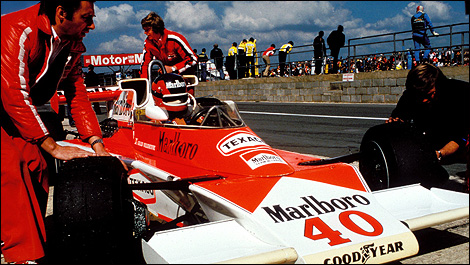 |
| Photo: WRi2 |
Former McLaren man Leo Wybrott picks up the story. “My position at that time at McLaren was project manager. My responsibilities were building and testing the new cars, but I was not a member of the actual race team. When there were special events, Teddy (Meyer) would always leave me and my group of people to run it. This is how we get to run Gilles,” Wybrott told Auto123.com from his retirement home in Australia.
“James (Hunt) and Jochen (Mass) were racing M26s. The car we allocated for Gilles was chassis number 8, the newest and best M23 available. Gilles came to the factory for a seat fitting, and he got a tour of the place with Teddy,” Wybrott said.
The crew of three was formed to run Villeneuve at Silverstone: Wybrott, Stevie Bun and John Hornby.
“We went straight into pre-qualifying. From very early on, from the moment he drove the car, there was a confidence and an ability about the person. It's one of those things you come across. From the lap times he was setting, we knew he was very capable,” Wybrott explained.
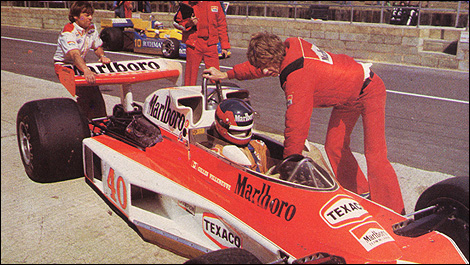 |
| Photo: Personal collection, Rights reserved |
Villeneuve emerged quickest in the pre-qualifying session, beating his good friend Patrick Tambay who was driving for Ensign and the 12 other drivers.
Gilles spun several times during his first day in the M23. “He was always near the top of the list. He had two or three spins early on, but he was learning. Later in the first practice session, he had more high-speed spins but he was getting to grips with the car. He was always bringing the car back in one piece. He ended up 11th fastest. This is when people started to become aware of his performance,” he continued.
“He was communicating with me so well, and we started to change the set-up of the car and he went faster and faster. At some point, we were 4th or 5th quickest. He eventually qualified 9th. We did not qualifying higher because we had not access to the soft Goodyear tires,” Wybrott recalled.
Saturday night, everyone wanted to know more about this young Canadian driver. “We kept having visitors coming to see us. Teddy (Mayer) came down and wanted to know the settings I had on the car. It was a huge stirring about this new driver and his ability. He was setting the whole place alight. He was a joy to work with. His wife Joann was there all the time with a lovely smiling face. Gilles stayed with us all nights, and he wanted to understand the complexity of the car. He stayed and talked to us. It was a genuine interest from his part to understand how the car was made and worked,” he declared.
“I then explained him about the gauges in the M23. Having worked at Lotus and driven F1 cars on occasions, I knew the Smith gauges were fully unreliable! I forgot to say to him that gauges sometime failed,” he added.
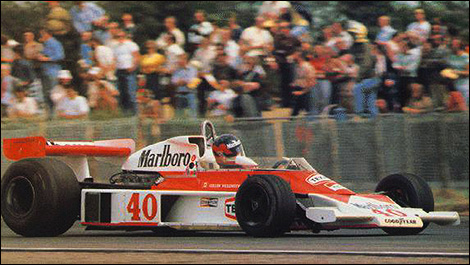 |
| Photo: Personal collection, Rights reserved |
Race day. The pit box of the No. 40 car was located way down the pit lane, near the entrance of Corner 1, Copse. Leo Wybrott and the signaller positioned themselves at the other end of the pits to give Villeneuve the chance to read the pit board before braking for Copse.
Gilles had a good start and ran very well early in the race. On lap 10, he was running in seventh place, unimpressed.
“Gilles was running well ahead of (Jochen) Mass and suddenly went missing. We saw him take the pit road flat out and he stopped at our box at the other end of the pits. The cars ran at extremely hot temperatures, the water barely managed to keep the cars cool enough to run. But the moment you stopped, the heat sinked from the engine into the water system without the pump circulating the water, and they just boiled instantly. The pressure cap on the header tank released the water through the bypass. And water poured from under the car. Gilles showed Stevie the needle of the water gauge stuck at maximum temperature. Stevie looked at the water pouring from the engine and was ready to tell him to retire,” Wybrott told us.
“I ran down the pit lane as fast as I could. Gilles was still in the car and he showed me the water gauge. I told me to watch the oil temp indicator - that will be a reliable source of information. The water temp did not matter. We quickly added some water in the system. We got the starter out and told him to fire the engine. He rejoined the race in 21st place but pushed hard an finished eleventh,” Wybrott recalled. Villeneuve also set the 5th fastest time if the race on lap 65.
“We were all very impressed with him. He and Joann sent me a card a week later, saying he was so thankful about the experience. Whenever they saw me afterwards, they both were very kind to me and came to talk a bit. He was a true gentleman,” Wybrott ended.
During our recent trip to Indianapolis with Chevrolet, we got the chance to visit the museum that houses approximately 75 vehicles are on display at all times.
We got the chance to see the infamous Marmon "Wasp," which won the inaugural Indianapolis 500 in 1911 with Ray Harroun at the wheel, the Duesenberg No. 12 Murphy Special, the only car ever to win both the Indianapolis 500 (1922) and the French Grand Prix at Le Mans (1921), the four cars driven to victory by A.J. Foyt Jr., including his 1977 machine that represents his record-setting fourth Indy 500 win.
 |
| Photos: René Fagnan/Auto123.com |
There are also more recent machines such as Jacques Villeneuve's Reynard-Ford that won the race in 1995, the yellow Pennzoil Chaparral (the first wing car at Indy), and the STP Lotus turbine car.
We also saw the 1972 Parnelli chassis designed by Maurice Phillipe that featured the so-called "dihedral" wings, and winglets that angle out of the sides of the chassis.
We also took some photos of the vintage Indy car that circulated the track on Saturday before the race.
For the Canadian, 2012 means a full-scale comeback in NCTS after spending the 2010 and 2011 seasons picking up starts in the NASCAR Sprint Cup Series, NASCAR Nationwide Series, NASCAR K&N Pro Series and the ARCA Racing Series.
The Roxton Pond native will be back behind the wheel of the No. 27 Dodge/GC Motorsports Dodge following the association between Dave Jacombs Racing and GC Motorsports International to form GC Motorsports Canada. GCMI, formerly Go Canada Racing.
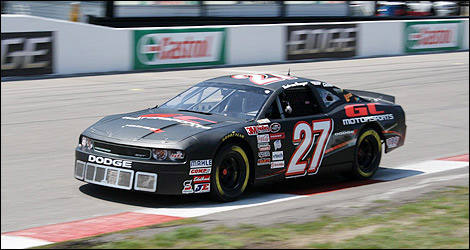 |
| Photo: GC Motorsports |
Last year, for the inaugural ICAR race, things did not go as planned. After competing in an ARCA event the night before and missing qualifying, Ranger had to start the event from the rear of the 27-car field. He picked his way through traffic on the 15-turn, 2.113-mile track and took the lead on Lap 28 of the 30-lap race.
Unfortunately, he made contact with polesitter Alex Tagliani which was deemed excessive by NASCAR officials resulting in an aggressive driving penalty and a finish in 21st place and some harsh words coming from Tagliani.
Qualifying is set for 4:00 p.m. ET on Saturday June 2nd while the green flag for the event is scheduled for Sunday at 1:30 p.m. ET
Aaro Vainio started from pole position, and maintained his lead until the end of the race, that he concluded ahead of Tamas Pal Kiss, who jumped from the second row to take second place ahead of Kevin Ceccon, who started from outside row 1, the Italian taking third position at the checkered flag.
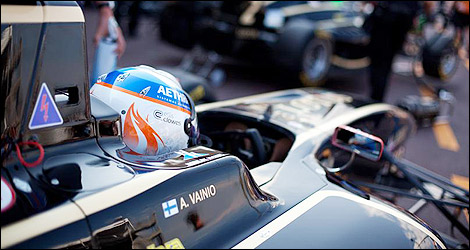 |
| Aaro Vainio on the starting grid. (Photo: GP3 Series) |
Marlon Stockinger, who concluded the first race at the 8th position, took benefit of his advantage, especially in Monaco, to claim his first GP3 win in race 2, ahead of Antonio Felix Da Costa, who put the pressure on him.
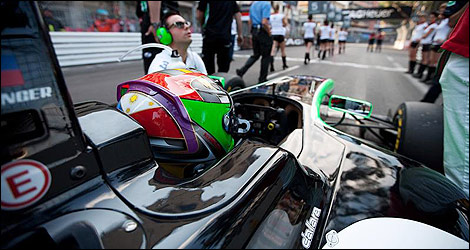 |
| Marlon Stockinger on the starting grid. (Photo: GP3 Series) |
The second race was shortened due to Conor Daly's massive crash, after his car flew in the air arriving at the chicane after a contact with Dimitry Suranovich. Daly escaped unhurt, so did Will Buller, which car rolled out at Sainte Devote after a contact with his team mate Alex Brundle at the start.
Race 1:
1. Aaro Vainio (Lotus) in 27'06''685
2. Tamas Pal Kiss (Atech CRS) +1''994
3. Kevin Ceccon (Ocean) +10''519
4. David Fumanelli (MW Arden) +16''156
5. Mitch Evans (MW Arden) +17''789
Etc.
Race 2:
1. Marlon Stockinger (Status) in 21'37''673
2. Antonio Felix Da Costa (Carlin) +0''687
3. Daniel Abt (Lotus) +1''820
4. Mitch Evans (MW Arden) +2''685
5. David Fumanelli (MW Arden) +3''651
Etc.
Championship:
1. Vainio 54 points, 2. Evans 43, 3. Stockinger 39, 4. Felix Da Costa 24, 5. Daly and Ceccon 23, etc.
1 - Driver who has have completed every lap of every race in the first five IZOD IndyCar Series events: James Hinchcliffe.
3 - Indianapolis 500 wins for Dario Franchitti, the 10th driver to win the Indianapolis 500 three or more times.
4 - Drivers to lead the Indianapolis 500 for the first time: Hinchcliffe, Takuma Sato, Charlie Kimball and Rubens Barrichello.
5 - Indianapolis 500 wins for car owner Chip Ganassi (1989, 2000, 2009, 2010 and 2012). Ganassi tied Lou Moore for second among Indianapolis 500 wining car owners.
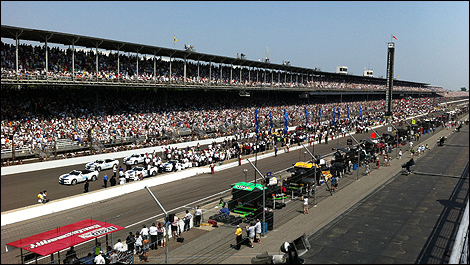 |
| (Photo: Rene Fagnan / Auto123.com) |
6 - Different teams represented in the top 10 in the IZOD IndyCar Series standings.
8 - Different teams represented in the top 10 of the 96th Indianapolis 500.
9 - Different drivers to finish on the podium in the first five races of 2012.
16 - Starting position of Dario Franchitti. The only other driver to win from 16th position was Dan Wheldon in 2005.
23 - Positions gained by Oriol Servia en route to his season-best performance of fourth at Indianapolis.
31 - Indy car wins for Dario Franchitti, tying Sebastien Bourdais and Paul Tracy as the active leader in victories.
34 - Lead changes among 10 drivers. It was the most lead changes in the Indianapolis 500 Mile Race.
36 - Points separating Power (200) from Helio Castroneves and James Hinchcliffe (164) in the IZOD IndyCar Series championship standings.
50 - Number carried by the Indianapolis 500 winner for the first time.
59 - Laps led by Marco Andretti. He had led 31 laps at Indianapolis in his previous six starts. It was the seventh time an Andretti had led the most laps at Indianapolis. Mario led the most laps in 1969, 1985, 1987 and 1993. Michael led the most laps in 1991 and 1992.
62 - Positions gained by Servia in the first five races of 2012. (An average of 12.2 positions per race)
91 - Degrees, the high temperature in Indianapolis on May 27, 2012 - tying the 1919 and 1953 as the second-hottest 500 Race Day.
109 - Top five finishes for Franchitti in his Indy car racing career.
186 - Consecutive Indy car starts for Tony Kanaan dating to the 2001 CART race in Portland.
1,366 - Consecutive laps completed by Scott Dixon at the Indianapolis 500, a race record. The previous record stood for 71 years and belonged to Wilbur Shaw, who completed 1,351 consecutive laps from 1935-41.
Sales have been dropping for the last seven months; retail sales have dropped 5 % in April. Total sales (retail and fleet sales) have gone backward by 16 % in the last quarter.
Buick is giving Cadillac a run for its money in terms of mediocrity - among the 41 brand sold in the US, they are competing for the longest bad spell. But, unlike Cadillac, Buick doesn't have a single new model up the horizon to dig itself out.
The American firm is trying to fight back by making leasing more affordable than ever. It seems the route to go: other luxury car retailers state leasing accounts for as much as 50 % for certain brands. They better come up with some serious offers if they plan on taking back their slice of the market.
Furthermore, some changes are on the way for Buick's two best-sellers; the Enclave is going back to the drawing board for the 2013 model year, and in two years the Regal should undergo some modifications as well.
Source: Automotive News
The movie is based on the intense rivalry between Ferrari driver Niki Lauda (played by Daniel Brühl) and Briton James Hunt (played by Chris Hemsworth), driving for McLaren.
No exact premiere date has been set for the movie, but it's expected to be released sometime next year.
Toro Rosso's gamble could have powered rookie Jean-Eric Vergne to victory in Monaco.
That is the claim of French commentator Patrick Tambay, a former Ferrari driver.
Red Bull junior team Toro Rosso was ridiculed late on Sunday by opting to pull Vergne from a points-running position on the essentially dry Monaco track in order to fit intermediate tires.
But according to Tambay, it was a gamble that could have seen the 22-year-old scythe through the field to victory.
 |
| Photo: Toro Rosso |
In the end, the heavy rain did not arrive until shortly after the chequered flag.
"If it had rained, he could have won," Tambay told RMC Sport. "Late in the race, everyone would have been on very worn dry tires with a lot of trouble staying on the track."
"Others could have dived into the pits but it would have been risky with so few laps to run. But with his (intermediate) tires, he (Vergne) would have been passing cars one after another. It was quite possible that he could have won the Monaco grand prix," added Tambay.